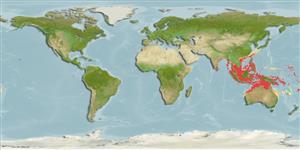Common names from other countries
Classification / Names / Names
Namen | Synonyme | Catalog of Fishes (gen., sp.) | ITIS | CoL | WoRMS
Environment: milieu / climate zone / depth range / distribution range
Ökologie
. Tropical
Indo-Pacific: from Pakistan, India and Sri Lanka to the Philippines; north to Japan and south to Indonesia.
Length at first maturity / Size / Gewicht / Alter
Maturity: Lm ? range ? - ? cm Max length : 10.0 cm ShH Männchen/unbestimmt; (Ref. 349); common length : 7.0 cm SHL Männchen/unbestimmt; (Ref. 349)
Incidentally collected in shrimp trawls (Ref. 349). Found in shallow subtidal zone on rocks and sand (Ref. 100442).
Life cycle and mating behavior
Geschlechtsreife | Fortpflanzung | Ablaichen | Eier | Fecundity | Larven
This species is a non-broadcast spawner. Life cycle does not include trocophore stage. Also Ref. 833.
Poutiers, J.M. 1998. (Ref. 349)
IUCN Rote Liste Status (Ref. 130435)
CITES Status (Ref. 108899)
Not Evaluated
Not Evaluated
Bedrohung für Menschen
Harmless
Nutzung durch Menschen
| FishSource |
Tools
Mehr Information
Alter/GrößeWachstumLänge-GewichtLänge-LängeMorphologieLarvenDichte
Internet Quellen
Estimates based on models
Preferred temperature
(Ref.
115969): 22.6 - 28.3, mean 26.8 (based on 509 cells).
Verwundbarkeit
Low vulnerability (10 of 100).
Preiskategorie
Unknown.
